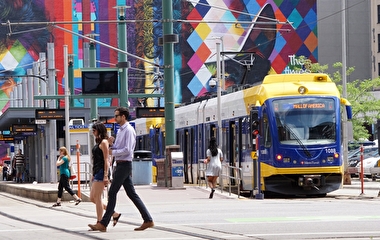In conjunction with National Bike Month, Accessibility Observatory lead researcher Brendan Murphy highlighted some of his bicycle-related research in two guest posts on the CTS blog in May.
In one post, Murphy explored the topic of “safety in numbers” for bicycles and outlined a Roadway Safety Institute project that investigated the presence of this phenomenon in Minneapolis. Safety in numbers refers to an individual pedestrian or bicyclist having a lower risk of being hit by a car in areas where more people are walking and biking. In the Institute study, Murphy and other U of M researchers attempted to predict crash rates between cars and bicycles at street intersections in Minneapolis based on traffic levels. The team then assessed whether there are areas of the city with much higher per-bicyclist crash rates.
Murphy also gave an update on the Accessibility Observatory’s work measuring access to jobs by bicycle. He explained that evaluating real-world bicycle accessibility is more challenging than measuring access by auto or transit since route planning by bicycle is more sensitive to factors such as road type, speed limit, and the presence (or lack) of dedicated infrastructure.
To account for this sensitivity—and more accurately identify the roads that cyclists will actually use—the Observatory is working to adapt a new framework to its research. The framework assigns a “stress level” ranking to individual roads based on data such as street width, number of lanes, speed limit, the presence of bike facilities, and other factors. The result, according to Murphy, will be not only more accurate metrics of access to destinations by bicycle but also a better way to evaluate how small changes in the bike network affect accessibility.



